Specific Process Knowledge/Characterization/Profiler: Difference between revisions
→Quality control of measurement accuracy: edited info on calibration |
→Quality control of measurement accuracy: edited info on calibration |
||
| Line 197: | Line 197: | ||
|} | |} | ||
|} | |} | ||
If the average value is | If the average value is outside the calibration limit, the instrument is calibrated straight away. | ||
If two consecutive measurements for a range are outside the action limit, the range should be calibrated. | If the average value is within the calibration limit, but outside of the action limit, the control measurement should be redone after 1 week. If two consecutive measurements for a range are outside the action limit, the range should be calibrated. | ||
The | The accuracy of the step height calibration is 0.15 µm for the 24.865 µm standard and 30 Å for the 9160 Å standard. These values are equivalent to twice the standard deviation, or 95 % confidence intervals. | ||
==Optical Profiler (Sensofar)== | ==Optical Profiler (Sensofar)== | ||
Revision as of 12:20, 3 June 2020
Feedback to this page: click here
Overview of the Nanolab profilers
All the profilers are compared on the topographic measurement page.
The sections below describe each profiler (Dektak stylus profilers and optical profilers) in more detail.
Dektak XTA stylus profiler
The Dektak XTA stylus profiler from Brüker is used for profiling surfaces of samples with structures in the micro- and nanometer range. The size of the structures that can be measured is limited by the tip dimensions.
A profile measurement can be done across a specific structure by using a high magnification camera to locate the structure. It is also possible to program the stylus to measure in several positions, defined with respect to some deskew points. Stress measurements of thin films can be done by measuring the wafer bow.
The user manual, quality control procedure and results, technical information and contact information can be found in LabManager:
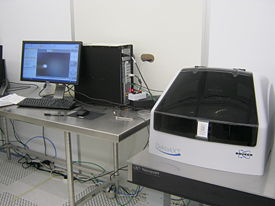
| Purpose | Profiler for measuring micro structures |
|
|---|---|---|
| Performance | Scan range x y |
Line scan x: 50 µm to 55 mm in a single scan, up to 200 mm with stiching |
| Scan range z |
50 Å to 1 mm | |
| Resolution x y |
Down to 0.003 µm | |
| Resolution z |
1 Å, 10 Å, 80 Å or 160 Å (for ranges 65 kÅ, 655 kÅ, 5240 kÅ and 1 mm respectively) | |
| Max scan depth as a function of trench width W |
1.2*(W[µm]-5µm) | |
| Hardware settings | Tip radius |
|
| Substrates | Substrate size |
|
| Substrate materials allowed |
|
Quality control of measurement accuracy
| Quality Control (QC) for DektakXTA | ||||||||||
|
If the average value is outside the calibration limit, the instrument is calibrated straight away.
If the average value is within the calibration limit, but outside of the action limit, the control measurement should be redone after 1 week. If two consecutive measurements for a range are outside the action limit, the range should be calibrated.
The accuracy of the step height calibration is 0.15 µm for the 24.865 µm standard and 30 Å for the 9160 Å standard. These values are equivalent to twice the standard deviation, or 95 % confidence intervals.
Dektak 8 stylus profiler
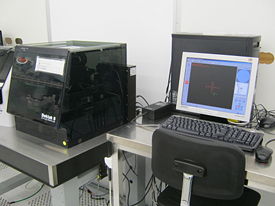
Dektak 8 stylus profiler is a product of Veeco Instruments. It is used for profiling surfaces of samples with structures in the micro- and nanometer range. The size of the structures that can be measured is limited by the tip dimensions.
It can measure specific structures found with the help of a high magnification video camera or it can be programmed to measure several points defined with respect to some deskew points. It can also be used for stress measurements of thin films by measuring the wafer bow.
The user manual, quality control procedure and results, technical information and contact information can be found in LabManager:
The original user manual can be obtained from the staff.
| Purpose | Profiler for measuring micro structures. |
|
|---|---|---|
| Performance | Scan range x y |
Line scan x: 50 µm to 100 mm |
| Scan range z |
50 Å to 1 mm | |
| Resolution x y |
Down to 0.067 µm | |
| Resolution z |
1 Å, 10 Å, 4 0Å or 160 Å (for ranges 65 kÅ, 655 kÅ, 2620 kÅ and 1 mm respectively) | |
| Max. scan depth as a function of trench width W |
1.2*(W[µm]-5µm) | |
| Hardware settings | Tip radius |
|
| Performance | Substrate size |
|
| Substrate material allowed |
|
Quality control of measurement accuracy
| Quality Control (QC) for Dektak 8 | ||||||||||
|
If the average value is outside the calibration limit, the instrument is calibrated straight away.
If the average value is within the calibration limit, but outside of the action limit, the control measurement should be redone after 1 week. If two consecutive measurements for a range are outside the action limit, the range should be calibrated.
The accuracy of the step height calibration is 0.15 µm for the 24.865 µm standard and 30 Å for the 9160 Å standard. These values are equivalent to twice the standard deviation, or 95 % confidence intervals.
Optical Profiler (Sensofar)
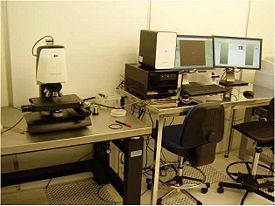
The PLu Neox 3D Optical Profiler (from Sensofar) has a dual-technology sensor head that combines confocal and interferometry techniques as well as thick and thin film measurement capabilities.
The Neox sensor head provides standard microscope imaging, confocal imaging, confocal profiling, PSI (Phase Shift Interferometry), VSI (Vertical Scanning Interferometry) and high resolution thin film thickness measurements on a single instrument.
The main purpose is 3D topographic imaging of surfaces, step height measurements in smaller trenches/holes than can be obtained with standard stylus methods (i.e. with aspect ratios higher that 1:1), roughness measurements with larger FOV (Field Of View) than the AFM, but less horisontal resolution.
For most samples the optical profiler provides fast and easy information without any sample preparation. However, it can be necessary to cover thin transparent layers (< 2 µm) with a thin layer of metal.
The resolution is limited by the objectives and the pixel resolution. Also the depth of focus is limited, especially for higher magnifications.
The user manual, technical information and contact information can be found in LabManager:
Optical profiler (Sensofar) info page in LabManager
Process Information
- Results from the Optical Profiler (Sensofar) acceptance test
- Sensofar presentation on how the sensofar works
- Plu neox leaflet including specifications
| Equipment | Optical profiler | |
|---|---|---|
| Purpose | 3D topographic imaging of surfaces. |
|
| Posibilities | Confocal and interferometric profiling and reflectometry |
|
| Performance | Depending on the objective chosen | |
| Substrates | Substrate size |
|
| Substrate materials allowed |
| |
Optical Profiler (Filmetrics)
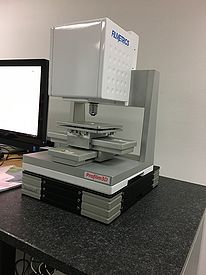
The Profilm3D optical profiler from Filmetrics uses white-light-interferometry (WLI) and phase-shifting-interferometry (PSI) to produce surface profiles and depth-of-field color images.
The main purpose is 3D topographic imaging of surfaces, step height measurements and roughness measurements with larger FOV (Field Of View) than the AFM, but less horisontal resolution.
For most samples the optical profiler provides fast and easy information without any sample preparation. However, it can be necessary to cover thin transparent layers (< 2 µm) with a thin layer of metal.
The resolution is limited by the objective and the sampling resolution.
The user manual, technical information and contact information can be found in LabManager:
Optical profiler (Filmetrics) info page in LabManager
| Equipment | Optical profiler | |
|---|---|---|
| Purpose | 3D topographic imaging of surfaces. |
|
| Posibilities | Interferometric profiling |
|
| Performance | With the current 10x objective | |
| Substrates | Substrate size |
|
| Substrate materials allowed |
| |
Dektak 3ST
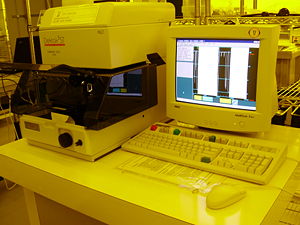
The Dektak 3ST is intended for profile measurements on samples outside the cleanroom.
The user manual, technical information and contact information can be found in LabManager:
Dektak 3ST (Dektak) in LabManager
The computer connected to the Dektak 3ST is pretty old and runs Windows 98 SE. It is not connected to the network but traces can be saved on either USB memory stick or floppy disk. The USB driver is an old universal driver and has been shown to work with small size USB sticks. However it did not work with an 8GB Kingston stick.
| Performance | Vertical Range |
|
|---|---|---|
| Scan length range |
| |
| Stylus track force |
| |
| Scan speed ranges |
| |
| Materials | Allowed substrate materials |
|
Stylus Profiler: Dektak150
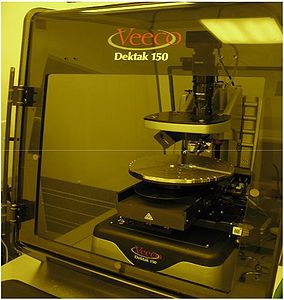
The stylus profiler Dektak150 is intended for profile measurements on samples outside the cleanroom.
The user manual, technical information and contact information can be found in LabManager:
Stylus profiler:Dektak150 in LabManager
The computer is not connected to the network but data can be saved on a dedicated USB and transfered to a computer on the network.
| Purpose | Profiler for measuring micro structures |
|
|---|---|---|
| Performance | Scan range x y |
Line scan x: 50 µm to 55 mm in a single scan |
| Scan range z |
50 Å to 1 mm | |
| Resolution x y |
Down to 0.003µm | |
| Resolution z |
1Å (@65kÅ), 10Å (@655 kÅ), 80 Å (@5240 kÅ), 160 Å (@1mm) | |
| Maximum sample thickness |
100mm | |
| Hardware settings | Tip radius |
|
| Substrates | Substrate size |
|
| Substrate materials allowed |
|

